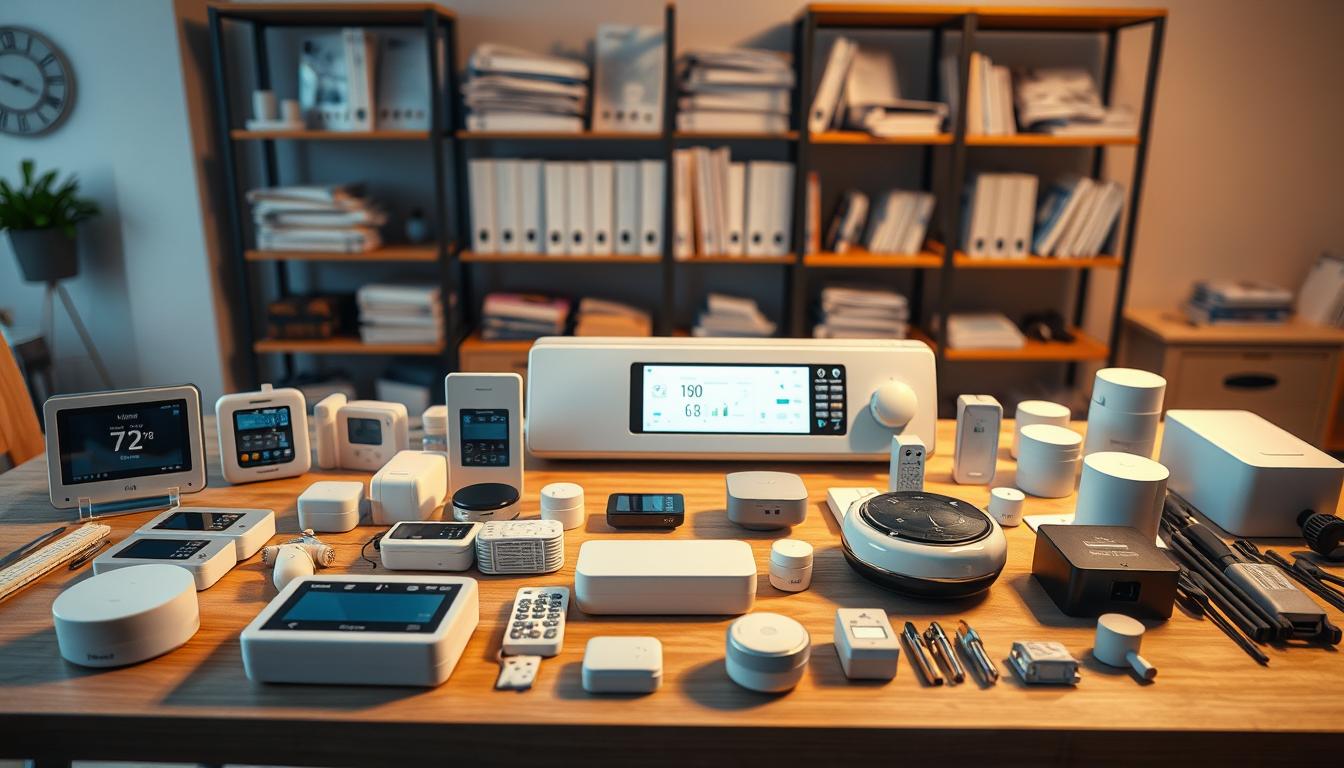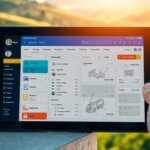Did you know companies using smart climate control tools save up to 40% on energy costs annually? This isn’t just about cutting bills—it’s a sign of how technology is reshaping an entire industry. Manual processes, like scheduling maintenance or tracking inventory, are being replaced by systems that work faster and smarter.
I’ve seen firsthand how teams struggle with missed appointments or delayed repairs. Coordinating field technicians, managing parts, and keeping customers happy can feel like juggling chainsaws. But here’s the good news: modern tools handle these tasks automatically, reducing errors and stress.
Why does this matter now? Clients expect instant updates and flawless service. If you’re still relying on paper schedules or spreadsheets, you’re falling behind. Automated solutions simplify everything—from dispatching crews to optimizing routes—so you can focus on delivering top-tier service.

Key Takeaways
- Smart tools cut energy costs by up to 40% while boosting system performance
- Automation eliminates manual errors in scheduling and inventory management
- Real-time updates improve customer satisfaction and technician productivity
- Route optimization reduces fuel costs and service delays
- Investing in these systems is critical for staying competitive
Understanding HVAC Business Automation Software
Imagine your team handling twice as many service calls without extra stress—how would that transform your operations? Modern tools designed for climate control teams act like a 24/7 assistant, quietly fixing problems before they escalate. Let’s explore how these digital helpers work and why they’re game-changers.
What It Is and How It Works
Think of these platforms as your building’s nervous system. Sensors track temperatures, airflow, and equipment health. The software analyzes patterns, spots inefficiencies, and sends alerts straight to your phone. I’ve watched teams ditch clipboards for dashboards that show real-time updates on every unit they manage.
One client reduced after-hours emergencies by 65% once their system started predicting filter failures. How? The tool cross-references historical data with current readings. When something looks off, it schedules maintenance automatically—no human oversight needed.
Key Benefits for HVAC Businesses
Cost savings jump out first. One office complex slashed energy bills by 30% after their platform optimized runtime schedules. But the perks go deeper. Dispatchers spend less time routing technicians because the software calculates the fastest paths based on traffic.
Customers also notice the difference. Automated reminders about tune-ups build trust. Instant invoices sent via text? That’s how you earn five-star reviews. These tools don’t just fix machines—they strengthen relationships.
Key Features of Leading Automation Platforms
What separates good climate control systems from great ones? It’s the hidden functionality that anticipates problems before they happen. Top platforms like Siemens Desigo, Johnson Controls Metasys, and Trane Tracer SC+ don’t just react—they learn. Their open-protocol designs let them “talk” to other building components, creating a unified network that adapts on the fly.

Real-Time Monitoring and Predictive Maintenance
Imagine sensors tracking every fan speed and temperature fluctuation. One client’s dashboard flagged an unusual vibration pattern in a rooftop unit. The system predicted a motor failure 11 days before it happened, saving them $8k in emergency repairs. These tools analyze historical patterns and current data to spot trouble early.
Technicians receive prioritized alerts straight to their devices. No more guessing which unit needs attention first. I’ve seen teams reduce downtime by 55% after implementing these predictive features.
Energy Management and Scheduling Tools
Smart platforms turn energy waste into savings opportunities. One school district cut costs by 30% after their system adjusted classroom temperatures based on occupancy sensors. The auto-scheduling feature considers weather forecasts, utility rates, and building usage patterns to optimize runtime.
Remote access lets managers tweak settings from their phones. During a heatwave last summer, a facility director lowered cooling demands during peak hours—avoiding $1,200 in surge pricing. These tools put control back in your hands, even when you’re off-site.
Top HVAC Software Solutions for 2025
What if your next software update could predict client needs before they call? The latest platforms combine smart features with budget-friendly options, giving teams an edge in competitive markets. Let’s explore standout tools reshaping how companies operate.
Innovative Tools and Unique Functionalities
Housecall Pro stands out with real-time job costing, letting teams track expenses against budgets instantly. Workyard’s GPS time tracking cuts payroll errors by 45%—I’ve seen crews recover hundreds of billable hours monthly. ShareWillow’s profit-sharing model turns maintenance plans into revenue streams, while Podium’s chat tools boost customer response rates by 60%.
FieldEdge uses AI to optimize technician routes, reducing drive times by 30%. One client saved $1,800 weekly on fuel after switching. ServiceTitan’s analytics dashboard spots underperforming equipment, helping companies upsell replacements proactively.
Comparing Customer Reviews and Pricing
Users praise Striven’s $35/month fleet tracking but note its learning curve. ServiceTrade earns top marks for custom workflows, though prices vary by team size. Workyard’s $6-16/user plan works for small crews, while Podium’s $399+ tier suits larger operations needing automated marketing.
Housecall Pro users love its invoice templates but wish for cheaper add-ons. When comparing, calculate total yearly costs—including training and support fees. Most platforms offer free trials; test those matching your workflow before committing.
Enhancing Operations with Automation and Analytics
What if your team could spot maintenance issues before customers notice? That’s the power of merging real-time data with smart tools. Gone are the days of scrambling to fix broken units—now you’ll catch problems while they’re still small.

Integrating Data for Smarter Decision Making
Modern platforms pull insights from everywhere: temperature sensors, technician notes, and even client feedback. I’ve watched teams combine these streams into a single dashboard that flags inefficiencies instantly. One hotel chain reduced emergency calls by 40% after linking their occupancy sensors to cooling schedules.
Analytics tools crunch numbers faster than any human. They’ll show you patterns like peak service hours or equipment aging trends. A school district saved $12k annually by adjusting runtime schedules based on these reports—no spreadsheets required.
Automated alerts keep projects on track. When a parts shipment delays a job, the system updates timelines and notifies clients automatically. Managers get real-time maps showing crew locations and inventory levels, making it easy to reroute resources mid-day.
Predictive features take it further. One retail client’s platform suggested filter replacements two weeks before failures occurred. Customers received appointment offers via text—before they even sensed a problem. That’s how you turn data into loyalty.
Exploring “HVAC business automation software” and Its Capabilities
Ever had a system that handles paperwork while your team focuses on customers? These platforms act like silent partners, tackling tedious tasks so your crew can shine where it matters. From tracking parts to sending bills, they’re built to handle the grind you’d rather skip.
I’ve watched teams ditch manual invoice tracking for auto-generated job site billing. One company cut billing errors by 70% after their system started matching work orders to client payments instantly. Stock levels update in real time too—no more guessing if you’ve got enough filters for next week’s jobs.
What makes these tools stand out? They learn as they go. After analyzing six months of service data, a client’s platform suggested optimal maintenance schedules that reduced after-hours calls by 40%. It even flags when specific equipment needs attention based on past performance.
Integration is seamless. These systems sync with your existing tools, creating a unified hub for everything from customer records to supplier contacts. Need to scale up? The platform grows with you, adding new features without disrupting daily workflows. That’s how you turn operational headaches into competitive advantages.
Streamlining Customer Communication and Dispatch
How much time does your team waste juggling customer messages and service requests? Modern tools turn this chaos into calm by merging every interaction into one streamlined hub. I’ve watched teams cut response times by half while boosting client satisfaction—here’s how it works.
Unified Messaging and Invoicing Tools
Platforms like Podium combine texts, emails, and live chats into a single dashboard. No more flipping between apps—you see all conversations in real time. One client reduced missed inquiries by 80% after switching. Auto-scheduled reminders keep customers informed about appointments, while instant payment links slash invoice delays.
Jobber’s CRM tools remember every detail: preferred service times, filter types, even allergy concerns. When Mrs. Johnson calls, her technician already knows her furnace history. This personal touch builds trust and repeat bookings. I’ve seen companies using these features grow referrals by 35% annually.
Smart dispatch systems assign jobs based on technician skills and location. A heat pump repair automatically routes to your nearest expert with certified training. Real-time traffic updates adjust routes mid-day, saving 22 minutes per call on average. Customers get accurate ETAs via text—no more “Where’s my technician?” calls.
Marketing tools send maintenance reminders before systems fail. One company’s automated campaigns boosted seasonal tune-ups by 50%. Follow-up surveys identify service gaps instantly, letting you fix issues before reviews go live. It’s like having a 24/7 customer service team that never sleeps.
Optimizing Fleet Management and Technician Routing
What if your team could handle three more service calls daily without hiring extra staff? Smart routing transforms mobile operations from chaotic to controlled. I’ve watched companies slash fuel costs by 25% while improving customer satisfaction—all through smarter deployment strategies.
Smart Navigation for Better Outcomes
Real-time GPS tracking gives managers eagle-eye visibility. One client reduced drive time by 30% after their system started rerouting crews around traffic jams. Customers get accurate ETAs via text, cutting “where’s my tech?” calls by half.
Advanced algorithms consider technician certifications and equipment needs. A heat pump repair automatically routes to your nearest expert with proper training. I’ve seen teams complete 22% more jobs weekly using these dynamic scheduling features.
Automated time tracking ends payroll disputes. Systems like Workyard clock technicians in/out based on GPS location. One company recovered 18 billable hours monthly—that’s $2,700 saved. Maintenance logs in Striven’s platform predict vehicle issues before breakdowns occur, keeping fleets rolling smoothly.
Route optimization tools analyze traffic patterns and job priorities. During a storm last winter, a client’s software rerouted crews to critical furnace repairs first. They averted 15 emergency callbacks while keeping response times under 90 minutes. That’s how you turn logistics into loyalty.
See how FieldAx can transform your Field Operations.
Try it today! Book Demo
You are one click away from your customized FieldAx Demo!
FAQ
What exactly is HVAC automation software, and how does it simplify daily tasks?
It’s a platform that handles scheduling, dispatching, and customer communication. I use it to automate repetitive tasks, track jobs in real time, and keep clients updated without manual input.
How can automation tools improve customer interactions in my HVAC business?
They centralize messaging, send automated reminders, and enable digital invoices. I’ve found this reduces missed appointments and speeds up payments through integrated credit card processing.
What features should I prioritize when choosing a management platform?
Focus on GPS route optimization, predictive maintenance alerts, and energy usage analytics. These help me cut fuel costs, prevent equipment failures, and advise clients on efficiency upgrades.
Are there affordable solutions for small HVAC teams just starting with automation?
Yes! HouseCall Pro offers scalable pricing with features like job scheduling and inventory tracking. I started with their basic plan and upgraded as my team grew.
How does real-time data integration enhance decision-making for HVAC operations?
By merging equipment performance stats with customer history, I can spot trends faster. This helps me allocate resources smarter and offer proactive maintenance plans.
Can these platforms handle complex dispatching for multiple technicians across regions?
Absolutely. Tools like ServiceTitan optimize routes based on location and skill set. I use their drag-and-drop scheduler to balance workloads and reduce drive time between jobs.
What security measures protect sensitive client data in cloud-based HVAC systems?
Top platforms use bank-grade encryption and role-based access. I always verify compliance with standards like PCI DSS before choosing a provider.
Author Bio
Co-Founder & CMO at Merfantz Technologies Pvt Ltd | Marketing Manager for FieldAx Field Service Software | Salesforce All-Star Ranger and Community Contributor | Salesforce Content Creation for Knowledge Sharing






